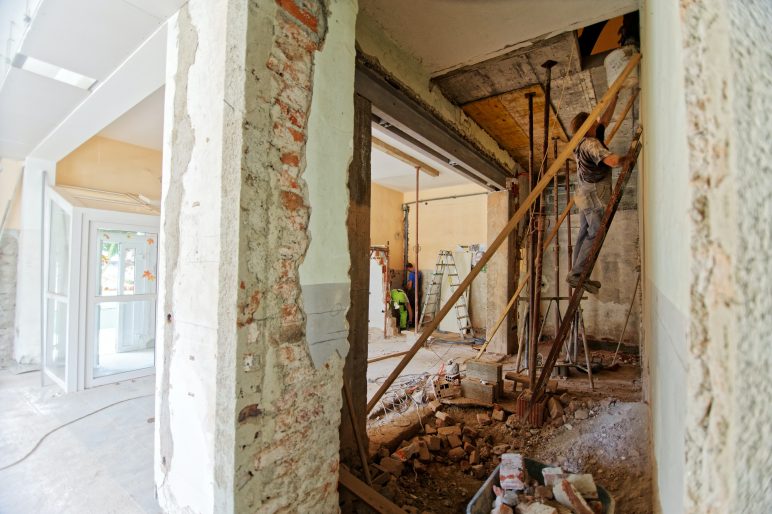Expansions and renovations bring a lot of excitement for tenants and management alike. However, disruptions to buildings can also disrupt pests’ habitats, as well as attract them.
If your facility is undergoing work, there are key steps you can take to help prevent pest infestations and invasions before, during and after construction.
Before construction
Before your construction begins, we recommend a pest management consultation to assess the site for pest types and pressures, review your plans, and develop a preventive program to help ensure as pest-free a design as possible. You’ll also want to take into consideration the additional challenges construction presents in keeping buildings sealed and shut properly: in particular, open wall voids and insulation provide harbourage and nesting to ants, rodents, and raccoons. Set up a meeting with your pest management provider to ensure all your bases are covered through your construction process.
Ensure any existing pest activity is controlled ahead of time to help reduce potential re-infestation and pest activity during construction. Pretreat any relevant areas for termites and other wood-infesting insects and, when possible, use non-cellulose building materials to minimize the chances of a termite issue. Avoid wood-to-ground contact at all costs throughout the construction (and supply storage) stage as well as in the construction planning.
Always have your construction manager inspect building supplies before bringing them onto the job site and again before using them to ensure pests do not hitchhike their way onto your site. Ensure a proper waste management plan is in place, such as what type of bins will be used and a schedule for emptying them, cleaning up wood or sawdust at the end of each day and removing old materials promptly from the site to avoid pests taking up residence in such areas or materials. Ensure landscaping is properly trimmed and not overgrown around the site perimeter to discourage pests from seeking shelter near or on the construction site.
During the work
Often during construction, typical physical barriers such as walls, windows, and doors are removed temporarily. Even if these openings are temporarily sealed off with plastic drapery or plywood structures, they are still an entry point for pests.
Work with your pest management provider to set up a primary line of defence through temper-resistant bait stations or traps around the exterior construction site. Utilize temporary bird monitoring or sound deterrents to avoid birds loitering around the site. Ensure the property has been properly graded so any collected water runs off away from the construction site and does not sit stagnantly, which attracts pests as well as breeds mosquitoes and midges. Ensure all gaps around the perimeter of these temporary structures are properly sealed off. Using weather stripping and sandbags can help keep these areas sealed without using permanent fixtures.
Finally, ensure the construction site stays clean. Food, trash, and wood debris are welcome snacks and shelter for pests, so keeping them off the job site can go a long way in helping keep pests away. If your construction site remains lit at night, use yellow (sodium vapour) lights to avoid attracting insects to the site where they will eventually end up indoors.
For the long haul
By thinking through your renovation plans ahead of time, you can design your building to be less friendly to unwanted pest tenants in the long run as well.
The first line of defence is the placement of exterior openings. For doors, windows, air vents, plumbing, and more, think about the location of these regarding pests. Note that roof structures are very prone to bird infestations, as birds find these to be the perfect location for a nest. Birds can also nest in ventilation along the sides of the buildings, so ensure proper mesh screens are placed on these openings to prevent any pests from roosting inside.
For ground-level structures, ensure openings at the building’s foundation are sealed. Double-check that your construction manager used weatherstripping on doors and that it was properly installed leaving no gaps. Make sure to address even small cracks or openings on the building’s foundation.
As mentioned above, cellulose-free building materials can do a lot of heavy lifting in terms of fending off termites. Termites feed on the cellulose in wood, so materials that do not contain cellulose reduce the risk of termite infestation down the line.
Sodium vapour lights are less attractive to flying pests than other light sources for outdoor areas. For outdoor areas, switch up the bulb type and keep them away from entry points as often as possible, which will help keep flying pests out of your building long term.
When planning landscaping for your building, avoid pest-attracting plants such as fruit trees, flowering shrubs, and ivy as well as other ground-covering foliage. When possible, place landscaping at least one metre away from the building to help keep pests away from the walls.
Whenever you decide to renovate or add on to your building, do so knowing you’ve done everything possible to mitigate potential pest problems down the road. Your pest management provider should be seen as a partner throughout the entire process to ensure your specific concerns are addressed.
Alice Sinia, Ph.D. is quality assurance manager of regulatory/lab services for Orkin Canada, focusing on government regulations pertaining to the pest control industry. With more than 20 years of experience, she manages the quality assurance laboratory for Orkin Canada and performs analytical entomology as well as provides technical support in pest/insect identification to branch offices and clients. For more information, email Alice Sinia at asinia@orkincanada.com or visit orkincanada.ca.





